Content is from Kirkbride et al. 2006Kirkbride et al. 2006:
Kirkbride JH, Jr, Gunn CR, and Dallwitz MJ. 2006. Family guide for fruits and seeds, vers. 1.0. Accessed September 2020-January 2022. URL: https://nt.ars-grin.gov/seedsfruits/keys/frsdfam/index.cfm ., without modification except with new images.
Updates are forthcoming.
Fruits: Pistil(s) compound; 1; 1-pistillate; with carpels united. Fruit pericarpium; simplesimple:
fruit formed from a single flower with one pistil, solitary carpel or several fused carpels
, or schizocarpschizocarp:
usually dry fruit splitting between two or more locules to form distinct, indehiscent, usually one seeded segments; fruit derived from a single, superior or inferior, compound ovary; compare to mericarp ; camara, or capsulecapsule:
; camara, or capsulecapsule:
a dry, dehiscent fruit derived from a compound ovary , or drupedrupe:
, or drupedrupe:
(indehiscent drupe) a fleshy, indehiscent fruit with one more hard pits enclosing seeds, derived from single, superior, simple or compound ovary; (dehiscent drupe) a fruit with a dry or fibrous to fleshy or leathery outer husk that early to tardily breaks apart (or opens), exposing one or more nutlike pits enclosing the seeds , or berryberry:
, or berryberry:
an indehiscent, fleshy fruit with one or a few to many seeds. The flesh may be homogenous throughout. Or, if the outer part is hard, firm, or leathery, referred to as an hesperidium. Septa are present in some, and the seeds may be arillate or with a fleshy testa. , or samarasamara:
, or samarasamara:
a winged, indehiscent, dry fruit containing a single (rarely two) seed(s) (Dodonoea); baccarium (Spjut 6 families: Apocynaceae, Oleaceae, Phytolaccaceae, Sapindaceae, Saururaceae, Trapaeolaceae), or camarium (Spjut 5 families: Gyrostemonaceae, Juncaginaceae, Malvaceae, Sapindaceae, Zygophyllaceae), or samarium (Spjut 7 families: Aceraceae, Malpighiaceae, Rhamnaceae, Sapindaceae, Simaroubiaceae, Trigoniaceae, Zygophyllaceae); loculicidalloculicidal:
(Dodonoea); baccarium (Spjut 6 families: Apocynaceae, Oleaceae, Phytolaccaceae, Sapindaceae, Saururaceae, Trapaeolaceae), or camarium (Spjut 5 families: Gyrostemonaceae, Juncaginaceae, Malvaceae, Sapindaceae, Zygophyllaceae), or samarium (Spjut 7 families: Aceraceae, Malpighiaceae, Rhamnaceae, Sapindaceae, Simaroubiaceae, Trigoniaceae, Zygophyllaceae); loculicidalloculicidal:
type of capsular dehiscence, opening longitudinally through the locules (compare septicidal)
 capsulecapsule:
capsulecapsule:
a dry, dehiscent fruit derived from a compound ovary (Spjut Fig. 37C-D), or septicidalsepticidal:
(Spjut Fig. 37C-D), or septicidalsepticidal:
type of capsular dehiscence, opening longitudinally by separating between the septa of adjacent carpels
 capsulecapsule:
capsulecapsule:
a dry, dehiscent fruit derived from a compound ovary , or pyxidium capsulecapsule:
, or pyxidium capsulecapsule:
a dry, dehiscent fruit derived from a compound ovary (latter 2 not Spjut); capsulecapsule:
(latter 2 not Spjut); capsulecapsule:
a dry, dehiscent fruit derived from a compound ovary not inflated; capsulecapsule:
not inflated; capsulecapsule:
a dry, dehiscent fruit derived from a compound ovary without operculumoperculum:
without operculumoperculum:
a dehiscent cap (or lid) of a seed or fruit that opens during germination or dehiscence
 ; without persistent central column; with (1–)2–6-carpellate (Dodonoea 5–6); with carpels united; with carpels remaining united at maturity; with carpels not radiating at maturity; with carpels remaining connected at stylestyle:
; without persistent central column; with (1–)2–6-carpellate (Dodonoea 5–6); with carpels united; with carpels remaining united at maturity; with carpels not radiating at maturity; with carpels remaining connected at stylestyle:
in a flower, the narrow and elongated part of the pistil between the stigma and the ovary; sometimes persisting in fruit ; without sterilesterile:
; without sterilesterile:
lacking male and/or female reproductive parts; also, not producing fruit or seed
 carpels; not sulcatesulcate:
carpels; not sulcatesulcate:
surface relief—having one or more elongate, relatively narrow and shallow depressions or grooves ; in transectiontransection:
; in transectiontransection:
a cross section; representing a plane made by cutting across an organ at a right angle to its length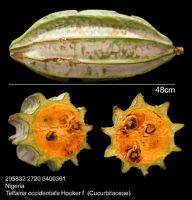 angled; 3-angled; apexapex:
angled; 3-angled; apexapex:
the point farthest from the point of attachment, or the "tip" of an organ not beaked; indehiscentindehiscent:
not beaked; indehiscentindehiscent:
not opening on its own, as in a fruit
 , or dehiscentdehiscent:
, or dehiscentdehiscent:
(v. dehisce) splitting open at maturity to release contents (of a fruit) . Dehiscentdehiscent:
. Dehiscentdehiscent:
(v. dehisce) splitting open at maturity to release contents (of a fruit) unit seed(s). Dehiscentdehiscent:
unit seed(s). Dehiscentdehiscent:
(v. dehisce) splitting open at maturity to release contents (of a fruit) passively (assumed); and shedding seeds; without replumreplum:
passively (assumed); and shedding seeds; without replumreplum:
the rim, formed by the persistent placentas, and connected by a false septum in Brassicaceae fruits. The fruit valves are attached to this rim and separate from it in dehiscent fruits.
. Epicarpepicarp:
outer layer of fruit wall or pericarp, if divided into layers; note here used synonymously with exocarp durable; membranousmembranous:
durable; membranousmembranous:
texture—extremely thin, pliable, and fairly tough
, or coriaceouscoriaceous:
texture—leathery
, or hard; not glabrousglabrous:
without hairs
(with hairs); hairs not glandularglandular:
surface relief—covered with small, raised secretory glands, regular or irregularly shaped, translucent or opaque, and maybe distinctly colored ; without armature, or with armature; with thorns (Paullinia riparia); without armature glochidiate; not smooth, or smooth; without wing(s), or with wing(s); 1–3-winged; with wing(s) apicalapical:
; without armature, or with armature; with thorns (Paullinia riparia); without armature glochidiate; not smooth, or smooth; without wing(s), or with wing(s); 1–3-winged; with wing(s) apicalapical:
at or pertaining to the end of the seed or fruit distal from its point of attachment (i.e., base)
, or laterallateral:
(of embryo) embryo lies along the side of the seed, generally towards one end; of, at, or from the side; in grasses, can refer to the sides adjacent to the dorsal and ventral sides
; without apicalapical:
at or pertaining to the end of the seed or fruit distal from its point of attachment (i.e., base)
respiratory hole. Mesocarpmesocarp:
the middle layer of the pericarp, if divided into layers absent, or present; fleshyfleshy:
absent, or present; fleshyfleshy:
texture—fairly firm and dense, juicy or at least moist, and easily cut
; composed of 1 unified layer; without lactiform cavity system. Endocarpendocarp:
the inner layer of the pericarp, if divided into layers present, or absent; not separating from exocarpexocarp:
present, or absent; not separating from exocarpexocarp:
outer layer of fruit wall or pericarp, if divided into layers; note here used synonymously with epicarp ; fibrousfibrous:
; fibrousfibrous:
texture—long, flexible threads, thicker than hairs, that densely cover and obscure the surface , or thinthin:
, or thinthin:
having or being of relatively little depth
, or woodywoody:
texture—consisting mainly of indurate lignified tissues, characteristic of or resembling wood
; without wing; without operculumoperculum:
a dehiscent cap (or lid) of a seed or fruit that opens during germination or dehiscence
 ; without secretory cavities; without mechanism for seedling escape; without grooves; without longitudinallongitudinal:
; without secretory cavities; without mechanism for seedling escape; without grooves; without longitudinallongitudinal:
of or relating to length or the lengthwise dimension
ridges. Funiculusfuniculus:
(alt. funicle) stalk connecting the ovule (later seed) to the ovary (later fruit) placenta short; short without seed bearing hooks (retinacula); not persisting in fruit after seed shed.
short; short without seed bearing hooks (retinacula); not persisting in fruit after seed shed.
Seeds: Arilaril:
(broad sense) appendicular structure that wholly or partly envelops a seed and is produced from or a modification of the funicle, raphe, or outer integument; usually fleshy or pulpy, sometimes spongy or tufted-capillate, often brightly colored present (see Pijl (1957) & Corner for details), or absent (about 1/2 genera); a true arilaril:
present (see Pijl (1957) & Corner for details), or absent (about 1/2 genera); a true arilaril:
(broad sense) appendicular structure that wholly or partly envelops a seed and is produced from or a modification of the funicle, raphe, or outer integument; usually fleshy or pulpy, sometimes spongy or tufted-capillate, often brightly colored , or an arillike structure; crimson red, or orange, or white, or yellow; well developed, or vestigal; adnate to hilumhilum:
, or an arillike structure; crimson red, or orange, or white, or yellow; well developed, or vestigal; adnate to hilumhilum:
on seeds, the scar indicating where the funiculus was attached; on grass caryopses, the scar visible on the outer fruit surface revealing where the seed is attached on the inner fruit wall surface; or in Asteraceae cypselae, the scar visible on the outer fruit wall revealing where the fruit was attached to the receptacle , or testatesta:
, or testatesta:
seed coat
 ; fleshyfleshy:
; fleshyfleshy:
texture—fairly firm and dense, juicy or at least moist, and easily cut
; of funicular origin, or micropylar origin, or outer integumentintegument:
ring-like or hood-like structure(s) that envelopes the nucellus, at maturity is the layers of the seed coat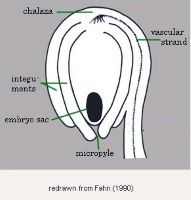 origin; basalbasal:
origin; basalbasal:
at or pertaining to the point of attachment; (of embryo) embryo occupies one end of the seed
; does not aid in seed explusion from fruit; fleshyfleshy:
texture—fairly firm and dense, juicy or at least moist, and easily cut
, or waxy; cupshaped, or saccate; unlobed, or lobed (Alectryon). Arillike structure falling with seed an arillode (either micropylar or micropylar-chalzal). Seed larger than minute; 1 to less than 5 mm long, or 5 to less than 10 mm long, or 10 to less than 25 mm long; 4–20 mm long; ellipsoidellipsoid:
3D shape—elliptic
, or circularcircular:
(of embryo) linear embryo is curved into an "O" shape ; in transectiontransection:
; in transectiontransection:
a cross section; representing a plane made by cutting across an organ at a right angle to its length flattened, or compressedcompressed:
flattened, or compressedcompressed:
flattened; in grasses, used to denote compression (not necessarily flattened) either laterally or dorsiventrally
, or tereteterete:
approximately circular in cross section; width and thickness approximately equal
 ; not bowl shaped; not nutlike; without winglike beakbeak:
; not bowl shaped; not nutlike; without winglike beakbeak:
a usually firm, terminal appendage, sometimes tapered ; without caudatecaudate:
; without caudatecaudate:
tapering to a long, tail-like appendage appendage(s); at maturity with food reserves; with perispermperisperm:
appendage(s); at maturity with food reserves; with perispermperisperm:
seed nutritive tissue comparable to the endosperm, but derived from the nucellus (maternal tissue)
, or endospermendosperm:
nutritive starch- and oil-containing tissue present in many seeds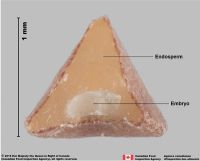 ; without canavanine. Sarcotestasarcotesta:
; without canavanine. Sarcotestasarcotesta:
pulpy or fleshy outer layer of the seed coat, simulates aril absent, or present; fleshyfleshy:
absent, or present; fleshyfleshy:
texture—fairly firm and dense, juicy or at least moist, and easily cut
. Testatesta:
seed coat
 present; without markedly different marginalmarginal:
present; without markedly different marginalmarginal:
at, on, or close to the margin or border
tissue; without fleshyfleshy:
texture—fairly firm and dense, juicy or at least moist, and easily cut
or leatheryleathery:
texture—moderately thick, tough, and very pliable
layer over hard layer, or with fleshyfleshy:
texture—fairly firm and dense, juicy or at least moist, and easily cut
or leatheryleathery:
texture—moderately thick, tough, and very pliable
layer over hard layer; tight; dulldull:
reflecting only a low proportion of incident light, with no apparent sheen , or shinyshiny:
, or shinyshiny:
uniformly reflecting a high proportion of incident light at all angles ; surface smooth; without crease or line separating cotyledons from hypocotyl-radicle, or with crease or line separating cotyledons from hypocotyl-radicle; without notch along margin where cotyledons from hypocotyl-radicle tip approach each other, or with notch along margin where cotyledons from hypocotyl-radicle tip approaching each other; without glands; without bristles; glabrousglabrous:
; surface smooth; without crease or line separating cotyledons from hypocotyl-radicle, or with crease or line separating cotyledons from hypocotyl-radicle; without notch along margin where cotyledons from hypocotyl-radicle tip approach each other, or with notch along margin where cotyledons from hypocotyl-radicle tip approaching each other; without glands; without bristles; glabrousglabrous:
without hairs
, or pubescentpubescent:
surface relief—bearing hairs
; with hairs over surface; with short hairs; densely hairy; with straight hairs; villousvillous:
surface relief—covered with long, soft, fine hairs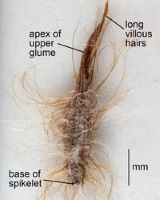 ; without glandularglandular:
; without glandularglandular:
surface relief—covered with small, raised secretory glands, regular or irregularly shaped, translucent or opaque, and maybe distinctly colored pubescence; without wings, or with wing(s) (Magonia); 1-winged; with wing encompassing seed; with wing(s) solid; with solid wing(s) similar to testatesta:
pubescence; without wings, or with wing(s) (Magonia); 1-winged; with wing encompassing seed; with wing(s) solid; with solid wing(s) similar to testatesta:
seed coat
 ; without collar; without operculumoperculum:
; without collar; without operculumoperculum:
a dehiscent cap (or lid) of a seed or fruit that opens during germination or dehiscence
 ; colored; monochrome; brown (all shades), or black, or yellow, or white, or orange (latter 3 for sarcotestasarcotesta:
; colored; monochrome; brown (all shades), or black, or yellow, or white, or orange (latter 3 for sarcotestasarcotesta:
pulpy or fleshy outer layer of the seed coat, simulates aril ); crustaceouscrustaceous:
); crustaceouscrustaceous:
texture—thin, dry, indurate, and brittle
, or membranousmembranous:
texture—extremely thin, pliable, and fairly tough
, or thinthin:
having or being of relatively little depth
, or hard; not becoming mucilaginousmucilaginous:
resembling mucilage; moist and sticky
when wetted; surrounding embryo. Hilumhilum:
on seeds, the scar indicating where the funiculus was attached; on grass caryopses, the scar visible on the outer fruit surface revealing where the seed is attached on the inner fruit wall surface; or in Asteraceae cypselae, the scar visible on the outer fruit wall revealing where the fruit was attached to the receptacle larger than punctatepunctate:
larger than punctatepunctate:
surface relief—dotted with pits or with translucent, sunken glands or with colored dots, similar to pitted ; heart-shapedheart-shaped:
; heart-shapedheart-shaped:
2D or 3D shape—one end has prominent double curved into two lobes, the other end angular or pointed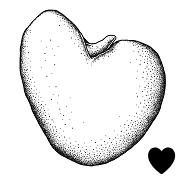 (white & finely pruinose: Cardiospermum). Rapheraphe:
(white & finely pruinose: Cardiospermum). Rapheraphe:
a ridge or seam on the seed coat, formed by the portion of the funiculus united to the ovule wall in longitudinally curved ovules conspicuous. Endospermendosperm:
conspicuous. Endospermendosperm:
nutritive starch- and oil-containing tissue present in many seeds development nuclear. Perispermperisperm:
development nuclear. Perispermperisperm:
seed nutritive tissue comparable to the endosperm, but derived from the nucellus (maternal tissue)
opaqueopaque:
not transmitting light
. Embryo differentiated from food reserve; well developed; 1 per seed; completely filling testatesta:
seed coat
 (no food reserve); chamber central to wings; 1 times the length of food reserve; at one end of seed not extending into a depression or cup; foliatefoliate:
(no food reserve); chamber central to wings; 1 times the length of food reserve; at one end of seed not extending into a depression or cup; foliatefoliate:
appearing leaf-like
; with spatulatespatulate:
2D shape—like a spatula; rounded at the apex, with base long and tapered; (of embryo) embryo is straight and axile and centric with the cotyledons expanded to form the shape of a spatula or spoon; (of cotyledons) cotyledons expanded and wider than the stalk but not invested into the stalk cotyledons; flatly coiledcoiled:
cotyledons; flatly coiledcoiled:
(of embryo) linear embryo is very long and bent to form a coil whereby one end of the embryo is on the outside and the other end near the middle of the seed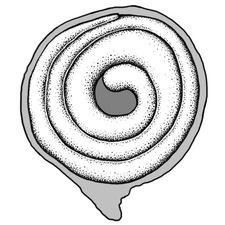 (circinate), or annularannular:
(circinate), or annularannular:
3D shape—forming a ring , or straight (& twisted); with cotyledons gradually connected to hypocotyl-radicle; without coleorhiza; without simmondsin; with cotyledons containing oils and starch; without stomata; green, or not green; with 2 or more cotyledons. Cotyledons 2, or 2 but appearing as 1 (frequently confluent into a fleshyfleshy:
, or straight (& twisted); with cotyledons gradually connected to hypocotyl-radicle; without coleorhiza; without simmondsin; with cotyledons containing oils and starch; without stomata; green, or not green; with 2 or more cotyledons. Cotyledons 2, or 2 but appearing as 1 (frequently confluent into a fleshyfleshy:
texture—fairly firm and dense, juicy or at least moist, and easily cut
mass); well developed; 0.6–0.9 times length of embryo; not concealing hypocotyl-radicle; incumbentincumbent:
(of cotyledons) having the dorsal side of one cotyledon resting against the radicle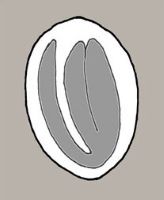 to hypocotyl-radicle; not foliaceous; thinthin:
to hypocotyl-radicle; not foliaceous; thinthin:
having or being of relatively little depth
, or thickthick:
having or being of relatively great depth
; circinatecircinate:
3D shape—terete and rolled downward from the apex in a tight coil
, or once-folded, or twisted, or plicate; smooth; with apicesapex:
the point farthest from the point of attachment, or the "tip" of an organ entire; with margins separate, or connate (fused into fleshyfleshy:
entire; with margins separate, or connate (fused into fleshyfleshy:
texture—fairly firm and dense, juicy or at least moist, and easily cut
mass); basally entire; equal in size; not punctatepunctate:
surface relief—dotted with pits or with translucent, sunken glands or with colored dots, similar to pitted dotted. Hypocotyl-radicle moderately developed, or well developed; not thickened; in pocket formed by testatesta:
dotted. Hypocotyl-radicle moderately developed, or well developed; not thickened; in pocket formed by testatesta:
seed coat
 therefore mostly separate from cotyledons.
therefore mostly separate from cotyledons.
Noxious weeds: 1 or more USA state noxious weeds in this family.
USA states and territories with listed noxious weeds: Alabama (AL), Arkansas (AR), Delaware (DE), Florida (FL), Georgia (GA), Kentucky (KY), Louisiana (LA), Maryland (MD), Mississippi (MS), Missouri (MO), North Carolina (NC), Oklahoma (OK), South Carolina (SC), Tennessee (TN), Texas (TX), and Virginia (VA).
USA state and territory noxious weeds:
Cardiospermum halicacabum L.: USA state noxious weed: AL●°, AR●°, DE°, FL°, GA°, KY°, LA°, MD°, MO°, MS°, NC°, OK°, SC°, TN°, TX°, VA°.
Cupaniopsis anacardioides (A. Rich.) Radlk.: USA state noxious weed: FL●.
Symbols: ªaquatic weed; ●terrestrial weed; °weed in seed.
Notes: Pijl (1957): "The seeds of the Sapindaceae show some remarkable features. One of them is the "Wurzeltasche or radicular pocket, separated from the main part of the seed by a 'deep fold in the testa'" … "The fleshyfleshy:
texture—fairly firm and dense, juicy or at least moist, and easily cut
part (around seed) may belong either to the seed itself or to the pericarppericarp:
fruit wall or fruit coat
. Structures are a) sarcotestasarcotesta:
pulpy or fleshy outer layer of the seed coat, simulates aril , b) micropylar arillode, c) micropylar-chalzal arillode (b & c are fleshyfleshy:
, b) micropylar arillode, c) micropylar-chalzal arillode (b & c are fleshyfleshy:
texture—fairly firm and dense, juicy or at least moist, and easily cut
parts of the testatesta:
seed coat
 , d) true arilaril:
, d) true arilaril:
(broad sense) appendicular structure that wholly or partly envelops a seed and is produced from or a modification of the funicle, raphe, or outer integument; usually fleshy or pulpy, sometimes spongy or tufted-capillate, often brightly colored , and e) endocarpendocarp:
, and e) endocarpendocarp:
the inner layer of the pericarp, if divided into layers pulpa".
pulpa".
Literature specific to this family: Pijl, L. van der. 1957. On the arilloids of Nephelium, Euphoria, Litchi, and Aesculus and the seeds of Sapindaceae in general. Acta Bot. Neerl. 6:618–641.
General references: Corner, E.J.H. 1976. The seeds of Dicots, esp. vol. 2. Cambridge University Press, New York, Cronquist, A. 1981. An integrated system of classification of flowering plants, 1,262 p. Columbia University Press, New York, Engler, A. & K. Prantl. 1924 and onward. Die Natürlichen Pflanzenfamilimien. W. Engelman, Leipzig, Gaertner, J. 1788–1805. De fructibus et seminibus plantarum. The Author, Stuttgart, Goldberg, A. 1986 (dicots) & 1989 (monocots). Classification, evolution, and phylogeny of the familes of Dicotyledons. Smithsonian Contr. Bot. 58 for dicots (314 pp.) & 71 for monocots (74 pp.). [Goldberg's illustrations are reproduced from older publications and these should be consulted], Gunn, C.R. & J.V. Dennis. 1976. World guide to tropical drift seeds and fruits, 240 pp. The New York Times Book Co., New York, Gunn, C.R. & C.A. Ritchie. 1988. Identification of disseminulesdisseminule:
detachable plant part capable of being disseminated and of propagating, commonly a seed or fruit
listed in the Federal Noxious Weed Act. Techn. Bull. U.S.D.A. 1719:1–313, Gunn, C.R., J.H. Wiersema, C.A. Ritchie, & J.H. Kirkbride, Jr. 1992 & amendments. Families and genera of Spermatophytes recognized by the Agricultural Research Service. Techn. Bull. U.S.D.A. 1796:1–500, Mabberley, D.J. 1987. The plant-book, 706 p. Cambridge University Press, Cambridge, Roosmalen, M.G.M. van. 1985. Fruits of the Guianan flora, 483 pp. Institute of Systematic Botany, Wageningen Agricultural University. Drukkerij Veenman B.V., Wageningen, Schopmeyer, C.S. 1974. Seeds of Woodywoody:
texture—consisting mainly of indurate lignified tissues, characteristic of or resembling wood
plants in the United States. Agric. Handb. 450:1–883, Spjut, R.W. 1994. A systematic treatment of fruit types. Mem. New York Bot. Gard. 70:1–182, and Mirle, C. & R.J. Burnham. 1999. Identification of asymmetrically winged samarassamara:
a winged, indehiscent, dry fruit containing a single (rarely two) seed(s) from the Western Hemisphere. Brittonia 51:1–14.
from the Western Hemisphere. Brittonia 51:1–14.